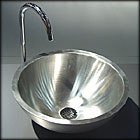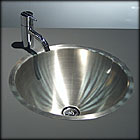Steel
Property


Steel
The term ‘steel’ usually refers to plain carbon steel, defined as alloys of iron and carbon that do not contain more than 2% carbon and are malleable in block and or ingot form.
Steel will have chemical composition containing:
- Carbon: 0.16-0.25%
- Manganese: 1.5-16%
- Silicon: 0.1-0.5%
Density And Thermal Properties
| Density at 20ºC (kg/m3) | Coefficient of thermal expansion x 10-6 /ºC | Thermal Conductivity (W/mK) | Specific Heat (J/ kgK) | |
| Pure Iron | 7870 | 12.1 | 78 | 455 |
| Wrought low carbon steel | 7860 | 12.2 | 65 | 480 |
| Cast low carbon steel | 7860 | 12.2 | 49 | 480 |
| Medium carbon steel | 7850 | 12.2 | 51 | 485 |
| High carbon steel | 7850 | 11.1 | 48 | 490 |
Source: Newnes Construction Materials Pocket Book
Vitreous enamel
A glazed surface finish produced by the application of a powdered inorganic glass, dry or suspended in water, to sheet steel parts and its subsequent fusion.
Vitreous enamel or porcelain enamel is ceramic made from kaolin, feldspar, and quartz
Stainless Steel
Constituents
The quality of stainless steel is imparted to steels by the presence of at least 12% of chromium in the steel. Oxidation and/ or corrosion produce a dense adherent oxide film which acts as a barrier to further corrosion.
| Martensitic steel | 13% chromium, and more than 0.1% carbon |
| Ferritic steel | 13-17% chromium, and < 0.08% carbon |
| Austhentic steel | Min 8% nickel, 17-24% chromium, max 0.1% carbon. |
Added Elements
Nickel and manganese are important added elements that produce special characteristics such as strength, toughness, and ease of fabrication in stainless steels. Columbium (niobium), molybdenum, phosphorus, selenium, silicon, sulphur, titanium, and zirconium are also used to give special characteristics. [14]
Material Properties
| Property | |
| Density | 8000 kg/m³ |
| Young’s modulus | 195 t/ 190 l kN/mm² |
| Thermal Conductivity | 15 W/ mºC |
| Co-efficient of thermal expansion | 1.6x 10-5/ ºC |
| Corrosion Resistance | Excellent |
| Melting point | 1425 ºC |
| Recyclability | Excellent |
| Primary embodied energy | 150 GJ/ m³ |
Source: Stacey, Michael; Component Design; Architectural Press; Oxford 2001.
Modulus Elasticity
| Stainless Steel | E (GPa) |
| Austenitic | 190-205 |
| Ferritic | 200-215 |
| Martensitic | 215 |
Fire and Heat Resistance
Special high chromium and nickel-alloyed grades resist scaling and retain strength at high temperatures.
Corrosion Resistance
Lower alloyed grades resist corrosion in atmospheric and pure water environments, while high-alloyed grades can resist corrosion in most acids, alkaline solutions, and chlorine bearing environments, properties which are utilized in process plants.
Impact Resistance
The austenitic microstructure of the 300 series provides high toughness, from elevated temperatures to far below freezing, making these steels particularly suited to cryogenic applications.